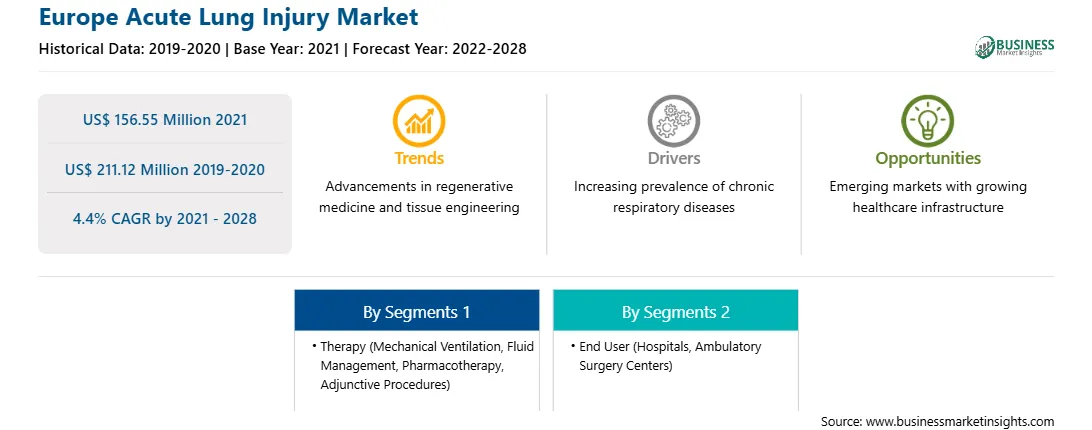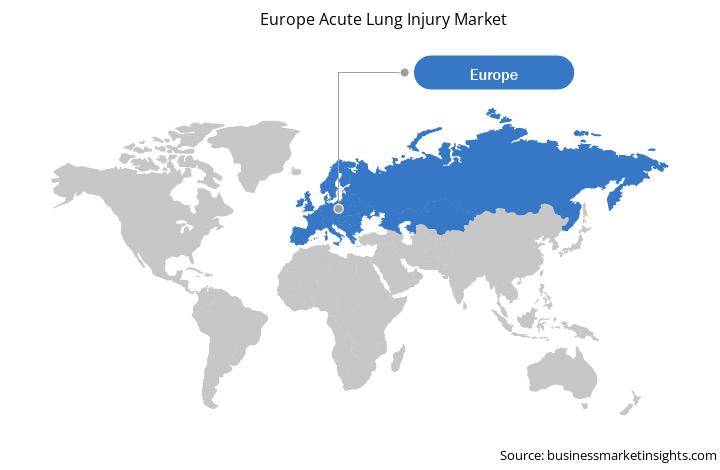The European acute lung injury market is divided into Germany, UK, France, Italy, Spain, and the rest of Europe. Germany led the market in 2021. Germany is much ahead in terms of the healthcare industry. It has the presence of market leaders from across the world. Also, there are well-established players across the country that is contributing to the overall healthcare industry, including diagnostics and treatment of acute lung injury. The use of e-cigarettes is associated with many patterns of lung injury, and as the use of these products continues to increase, these patterns have only recently been confirmed. For instance, according to National Center for Biotechnology Information, since 2001, the traditional smoking rate of adolescents between 14 and 17 years old in Germany has declined. The opposite trend of e-cigarette consumption can be observed. Trends such as “juuling” are attracting more attention from adolescents. The popularity is reflected in the numbers: Currently, 20.2% of young people aged 14-17 in Germany have used e-cigarettes. Although it is believed that the risk of exposure to potentially harmful components of e-cigarettes is significantly lower than that of combustible cigarettes, exposure to e-cigarette aerosols during adolescence and early adulthood is not without risks and may cause lung toxicity. Similarly, according to National Center for Biotechnology Information, the reported prevalence of ever-use of E-cigarette in Germany is 11.8%. Growing prevalence of respiratory diseases and surging technological advancements by market players are the major factor driving the growth of the Europe acute lung injury market.
In case of COVID-19, Spain, Italy, Germany, France, and the UK are among the most affected European countries. As per the Worldometer, as of September 16, 2021, Spain, UK, Italy, Germany, and France recorded 4,922,249; 7,312,683; 4,618,040; 4,117,263; and 6,926,604, respectively, COVID-19 cases, and the deaths toll is also high in these countries. In addition, Novel coronavirus-associated disease (COVID-19) was first detected in Spain on 31 January 2020, with more than 204 178 cases subsequently identified in 3 months.1 Severe COVID-19 is associated with high circulating levels of inflammatory cytokines akin to a cytokine release syndrome that frequently results in respiratory failure. To date, scant histopathological information of infected patients is available. Few descriptions of histopathological findings have mainly reported pneumonitis and diffuse alveolar damage (DAD).2–5 To advance in the knowledge of COVID-19-associated tissue damage is important to understand the mechanisms of damage caused by SARS-COV-2.

Strategic insights for the Europe Acute Lung Injury provides data-driven analysis of the industry landscape, including current trends, key players, and regional nuances. These insights offer actionable recommendations, enabling readers to differentiate themselves from competitors by identifying untapped segments or developing unique value propositions. Leveraging data analytics, these insights help industry players anticipate the market shifts, whether investors, manufacturers, or other stakeholders. A future-oriented perspective is essential, helping stakeholders anticipate market shifts and position themselves for long-term success in this dynamic region. Ultimately, effective strategic insights empower readers to make informed decisions that drive profitability and achieve their business objectives within the market.

| Report Attribute | Details |
|---|---|
| Market size in 2021 | US$ 156.55 Million |
| Market Size by 2028 | US$ 211.12 Million |
| CAGR (2021 - 2028) | 4.4% |
| Historical Data | 2019-2020 |
| Forecast period | 2022-2028 |
| Segments Covered |
By Therapy
|
| Regions and Countries Covered | Europe
|
| Market leaders and key company profiles |
|
The geographic scope of the Europe Acute Lung Injury refers to the specific areas in which a business operates and competes. Understanding local distinctions, such as diverse consumer preferences (e.g., demand for specific plug types or battery backup durations), varying economic conditions, and regulatory environments, is crucial for tailoring strategies to specific markets. Businesses can expand their reach by identifying underserved areas or adapting their offerings to meet local demands. A clear market focus allows for more effective resource allocation, targeted marketing campaigns, and better positioning against local competitors, ultimately driving growth in those targeted areas.

The Europe acute lung injury market is expected to grow from US$ 156.55 million in 2021 to US$ 211.12 million by 2028; it is estimated to grow at a CAGR of 4.4% from 2021 to 2028. The degeneration of various cells or tissues with age leads to a greater risk of multiple diseases. Elderly people are more prone to get affected by the failure of organs such as the lungs, heart, and kidney. This is mainly ascribed to the changes in the composition and metabolic activities in the ecosystem of the aging human body. With the increasing age, the incidence of organ systems efficiency decreases resulting prone to diseases such as respiratory diseases and other infection, thereby driving the target market. Thus, ALI is correlated with increased morbidity and mortality in the aging population. Also, age is generally reported as a risk factor for the growth of ARDS. Along with developed countries such as UK, France, and Germany, developing countries are experiencing significant growth in the geriatric population. The population is aging; over 65s are expected to account for 1 in 6 of the population by 2050, increasing 1 in 11 in 2019. With a strong association between aging and increased incidence of diseases—including respiratory conditions such as chronic obstructive pulmonary disease and acute infection—thorough research on the impact of disease risk and severity will be necessary to manage the health of an ever-aging population effectively. The growth of the geriatric population in these countries is driven by improved healthcare facilities and better healthcare services, which has resulted in increased life expectancy. Thus, the growing aging population is among the major factors for the growth of the Europe acute lung injury market.
In terms of therapy, the mechanical ventilation segment accounted for the largest share of the Europe acute lung injury market in 2020. In terms of end user, the hospitals segment held a larger market share of the Europe acute lung injury market in 2020.
A few major primary and secondary sources referred to for preparing this report on the Europe acute lung injury market are company websites, annual reports, financial reports, national government documents, and statistical database, among others. Major companies listed in the report are Apeiron Biologics AG; APEPTICO Forschung und Entwicklung GmbH; GlaxoSmithKline Plc; Histocell; Stemedica Cell Technologies, Inc; and Windtree Therapeutics, Inc.
The Europe Acute Lung Injury Market is valued at US$ 156.55 Million in 2021, it is projected to reach US$ 211.12 Million by 2028.
As per our report Europe Acute Lung Injury Market, the market size is valued at US$ 156.55 Million in 2021, projecting it to reach US$ 211.12 Million by 2028. This translates to a CAGR of approximately 4.4% during the forecast period.
The Europe Acute Lung Injury Market report typically cover these key segments-
The historic period, base year, and forecast period can vary slightly depending on the specific market research report. However, for the Europe Acute Lung Injury Market report:
The Europe Acute Lung Injury Market is populated by several key players, each contributing to its growth and innovation. Some of the major players include:
The Europe Acute Lung Injury Market report is valuable for diverse stakeholders, including:
Essentially, anyone involved in or considering involvement in the Europe Acute Lung Injury Market value chain can benefit from the information contained in a comprehensive market report.